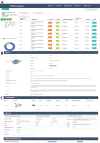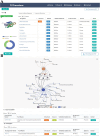ISTransbase: an online database for inhibitor and substrate of drug transporters
- PMID: 38943608
- PMCID: PMC11214160
- DOI: 10.1093/database/baae053
ISTransbase: an online database for inhibitor and substrate of drug transporters
Abstract
Drug transporters, integral membrane proteins found throughout the human body, play critical roles in physiological and biochemical processes through interactions with ligands, such as substrates and inhibitors. The extensive and disparate data on drug transporters complicate understanding their complex relationships with ligands. To address this challenge, it is essential to gather and summarize information on drug transporters, inhibitors and substrates, and simultaneously develop a comprehensive and user-friendly database. Current online resources often provide fragmented information and have limited coverage of drug transporter substrates and inhibitors, highlighting the need for a specialized, comprehensive and openly accessible database. ISTransbase addresses this gap by amassing a substantial amount of data from literature, government documents and open databases. It includes 16 528 inhibitors and 4465 substrates of 163 drug transporters from 18 different species, resulting in a total of 93 841 inhibitor records and 51 053 substrate records. ISTransbase provides detailed insights into drug transporters and their inhibitors/substrates, encompassing transporter and molecule structure, transporter function and distribution, as well as experimental methods and results from transport or inhibition experiments. Furthermore, ISTransbase offers three search strategies that allow users to retrieve drugs and transporters based on multiple selectable constraints, as well as perform checks for drug-drug interactions. Users can also browse and download data. In summary, ISTransbase (https://istransbase.scbdd.com/) serves as a valuable resource for accurately and efficiently accessing information on drug transporter inhibitors and substrates, aiding researchers in exploring drug transporter mechanisms and assisting clinicians in mitigating adverse drug reactions Database URL: https://istransbase.scbdd.com/.
© The Author(s) 2024. Published by Oxford University Press.
Conflict of interest statement
None declared.
Figures






Similar articles
-
TSdb: a database of transporter substrates linking metabolic pathways and transporter systems on a genome scale via their shared substrates.Sci China Life Sci. 2011 Jan;54(1):60-4. doi: 10.1007/s11427-010-4125-y. Epub 2011 Jan 21. Sci China Life Sci. 2011. PMID: 21253872
-
Human membrane transporter database: a Web-accessible relational database for drug transport studies and pharmacogenomics.AAPS PharmSci. 2000;2(3):E20. doi: 10.1208/ps020320. AAPS PharmSci. 2000. PMID: 11741236 Free PMC article.
-
TCDB: the Transporter Classification Database for membrane transport protein analyses and information.Nucleic Acids Res. 2006 Jan 1;34(Database issue):D181-6. doi: 10.1093/nar/gkj001. Nucleic Acids Res. 2006. PMID: 16381841 Free PMC article.
-
Evaluation of Proposed In Vivo Probe Substrates and Inhibitors for Phenotyping Transporter Activity in Humans.J Clin Pharmacol. 2016 Jul;56 Suppl 7:S82-98. doi: 10.1002/jcph.736. J Clin Pharmacol. 2016. PMID: 27385182 Review.
-
Transporter assays as useful in vitro tools in drug discovery and development.Expert Opin Drug Discov. 2016;11(1):91-103. doi: 10.1517/17460441.2016.1101064. Epub 2015 Oct 29. Expert Opin Drug Discov. 2016. PMID: 26512742 Review.
References
-
- Cheng Y., El-Kattan A., Zhang Y. et al. (2016) Involvement of drug transporters in organ toxicity: the fundamental basis of drug discovery and development. Chem. Res. Toxicol., 29, 545–563. - PubMed
-
- Kitamura S., Maeda K., Wang Y. et al. (2008) Involvement of multiple transporters in the hepatobiliary transport of rosuvastatin. Drug Metab. Dispos., 36, 2014–2023. - PubMed
-
- König J., Müller F. and Fromm M.F. (2013) Transporters and drug-drug interactions: important determinants of drug disposition and effects. Pharmacol. Rev., 65, 944–966. - PubMed
MeSH terms
Substances
Grants and funding
LinkOut - more resources
Full Text Sources
Miscellaneous

